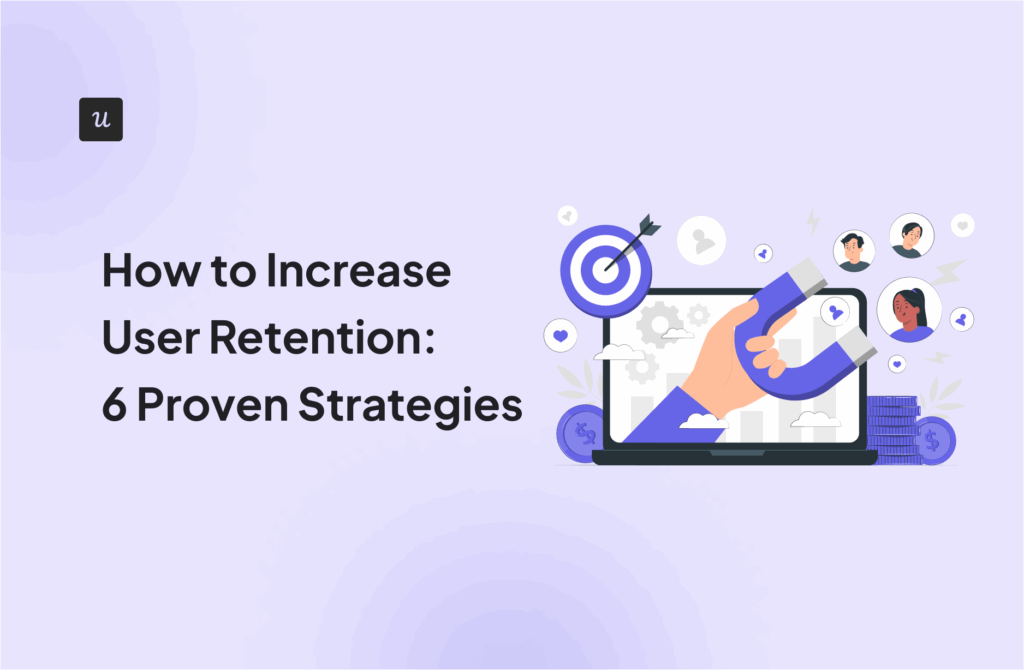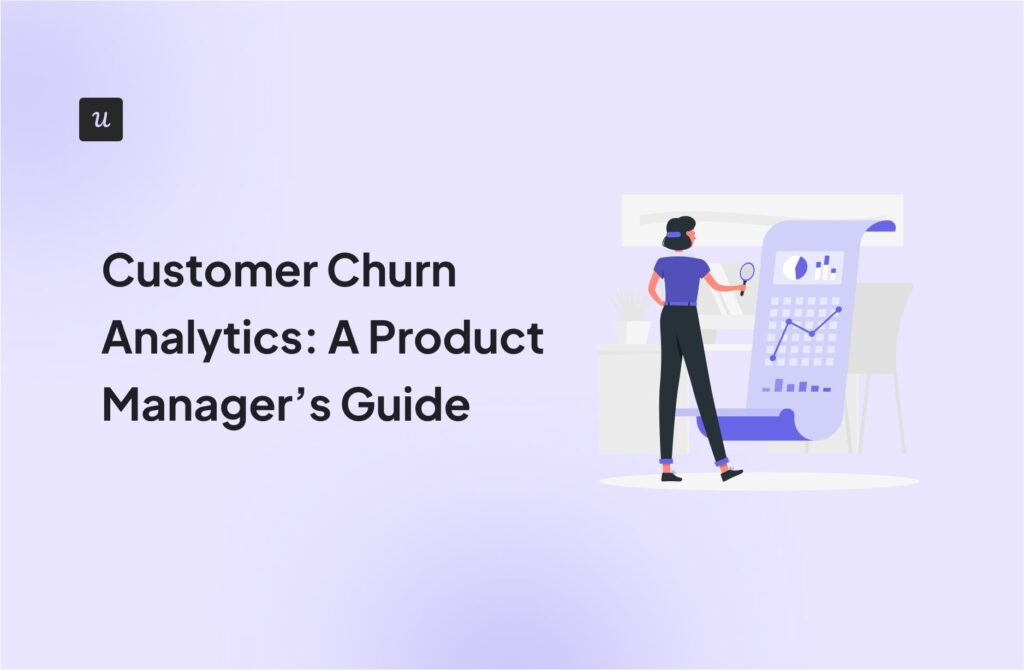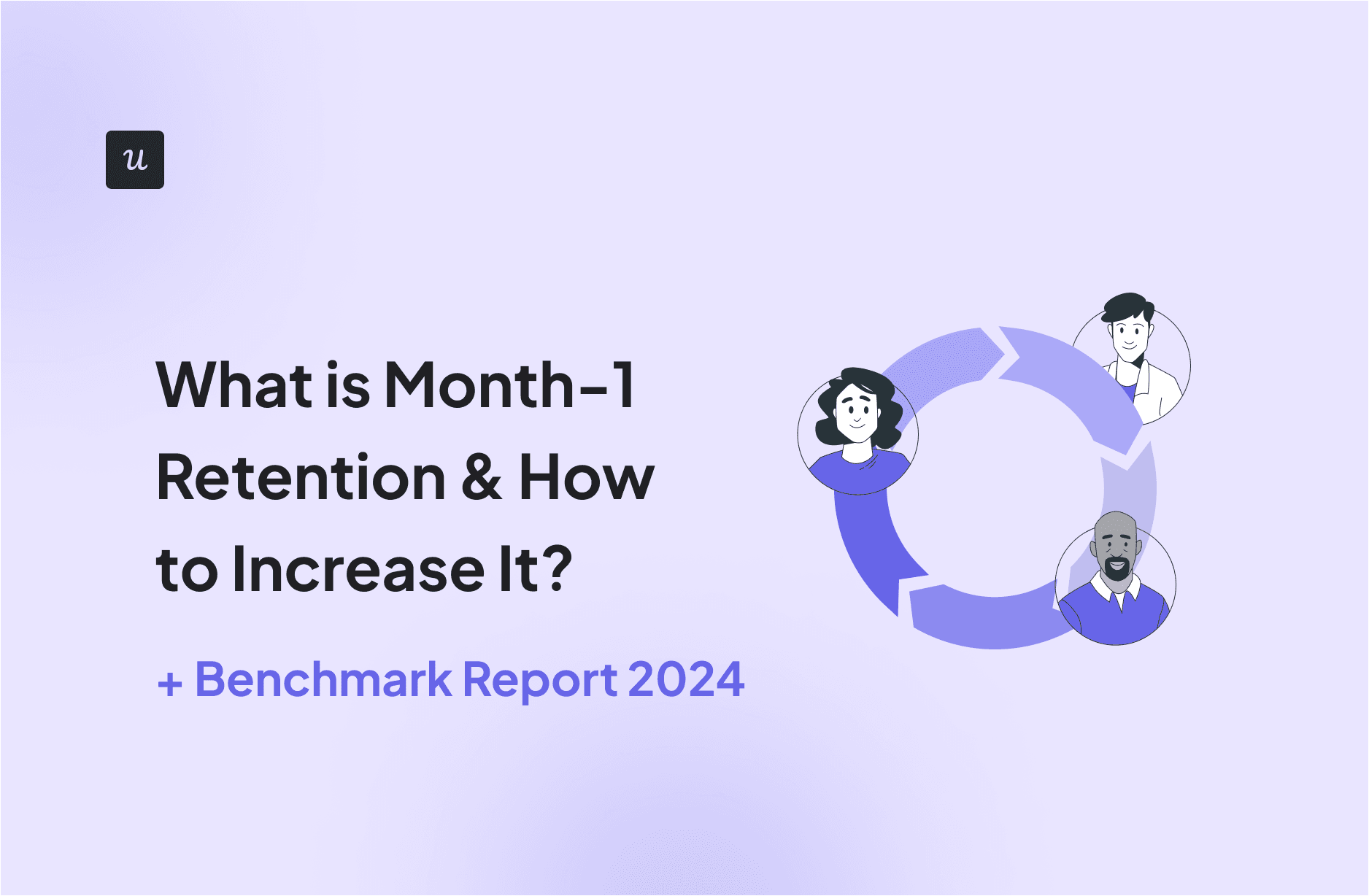
According to our benchmark, the average month-1 retention rate in SaaS companies is 46.9%.
But how does your business fare against companies at the same stage and industry?
Let’s explore our product metrics benchmark and learn:
- The definition of month-1 retention rate and why it matters.
- Average month-1 retention statistics for different segments.
- Strategies to improve your month-1 retention rate.
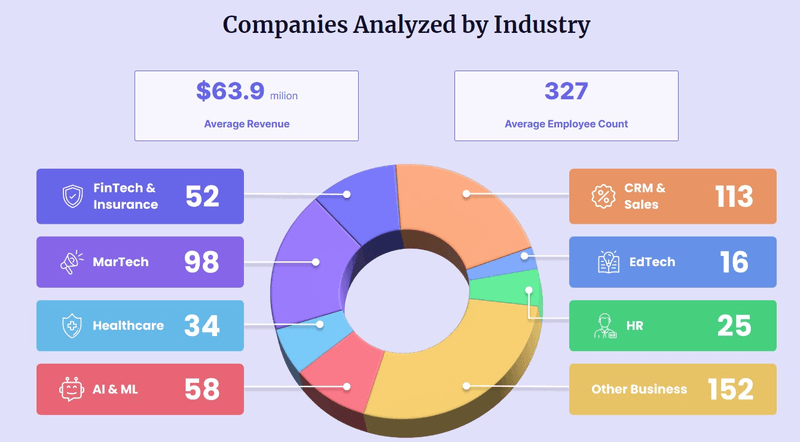
Try Userpilot Now
See Why 1,000+ Teams Choose Userpilot

Month-1 retention rate benchmarks – quick summary
- Month-1 retention rate measures the percentage of users who continue using a product one month after sign-up. It’s crucial for gauging early engagement and sustained value.
- Month-1 retention rate is important because it indicates effective onboarding and product value—predicting long-term retention and increasing CLV.
- According to our benchmark report that pulled data from 83 B2B SaaS companies, the average retention rate is 46.9%, while the median is 45.25%. It has significant variations across different segments, including:
- Industry: Retention rates vary by industry, with Fintech and Insurance leading at 57.6%, and Healthcare lagging at 34.5%.
- Company size: Smaller companies ($1M-$10M revenue) tend to have higher retention rates (around 47.9% to 49.3%). This, due to their flexibility when providing personalized experience and capacity to build trust.
- Growth model: Product-Led Growth (PLG) strategies show better retention (48.4%) compared to Sales-Led Growth (SLG) strategies (39.1%). Probably due to PLG’s self-service approach and personalized experiences.
- Here are effective strategies to improve 1st month retention rates:
- Provide seamless onboarding experience: Personalized onboarding through welcome surveys and tailored onboarding flows enhances early user retention.
- Offer consistent customer support: An in-app resource center and well-organized knowledge base reduce friction and prevent churn.
- Trigger in-app guidance with interactive walkthroughs: Interactive, real-time, and progressive onboarding enhances user understanding and retention of core features.
- Use gamification to engage users: Incorporating badges, levels, daily quests, and progress bars motivates and retains users through engaging and rewarding experiences.
- Why not book a Userpilot demo today to see how you can personalize the onboarding experience, provide self-service support, and retain more users?
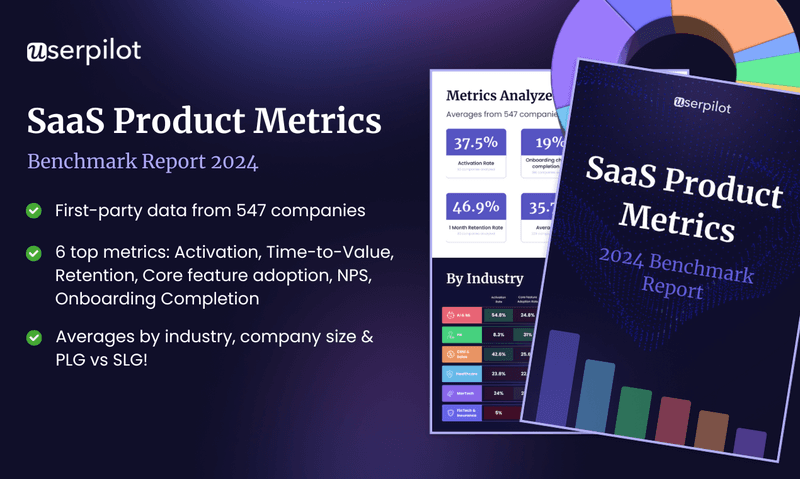
What is the month-1 retention rate?
Month-1 retention rate measures the percentage of users who continue to use a product or service one month after their initial sign-up. It’s a key metric for understanding user engagement and the product’s ability to deliver sustained value early in the customer lifecycle.
Why is month-1 retention rate important for SaaS businesses?
As mentioned, month-1 retention is a key indicator of a product’s capacity to provide value early—and it can make or break your business.
High month-1 retention rates suggest that your product is meeting user needs, that users find immediate value in your product, and that your primary onboarding process is effective.
That said, there are even more benefits to measuring retention rates:
- Predicts Long-Term Retention: Early retention rates can forecast long-term customer loyalty.
- Indicates Product-Market Fit: High retention suggests your product meets market needs.
- Improves Customer Lifetime Value (LTV): Better retention leads to higher CLV.
- Reduces Churn Costs: Keeping customers is more cost-effective than acquiring new ones.
- Guides Product Development: Insights from retention data help improve the product.
- Enhances Revenue Stability: Consistent retention ensures steady revenue streams.
What is the average month-1 retention rate for SaaS companies?
For the 1st month retention section of our benchmark report for 2024, we studied 83 B2B SaaS companies to learn about their performance.
The overall metrics included:
- Average month-1 retention rate: 46.9%
- Median month-1 retention rate: 45.25%
Now, this report also reveals different rates across various segments within the SaaS industry. These segments include industry type, company size, and growth strategy approach (PLG vs SLG), and here are the insights we found:

Average month-1 retention rate by industry
We found that retention rates can vary significantly depending on your industry. Which means there are different challenges and user engagement strategies within each sector.
That said, here are the average retention rates by industry:
- Martech: 44.7%
- CRM & Sales: 52.5%
- Fintech and Insurance: 57.6%
- Healthcare: 34.5%
- HR: 41.4%
- AI & ML: 53.6%
These results show how different industries engage users and the unique challenges they face. For example, industries like Fintech and Insurance tend to have higher retention rates due to the associated commitment required for their services, which fosters trust and long-term engagement.
On the other hand, sectors like Healthcare, HR, and Martech may struggle with retention either due to strict regulations, higher needs for personalization, differentiation, or high competition.

Average month-1 retention rate by company size
The results also indicated that retention rates can slightly differ based on company size, reflecting how different resources and strategies impact user engagement.
Here are the average retention rates by company size:
- $1,000,000 – $5,000,000 annual revenue: 47.9%
- $5,000,001 – $10,000,000: 49.3%
- $10,000,001 – $50,000,000: 45%
- $50,000,001+: 44.7%
According to this data, smaller companies seem to have higher retention rates. Probably due to their agility when it comes to personalizing the product experience, closer customer relationships, and their ability to adapt to user needs, fast.
But as companies start growing in size—and despite having more resources—they may face challenges in maintaining personalized interactions and building trust early due to their scale.
Note: It’s worth adding that 95% of the companies analyzed had a new user onboarding flow implemented. This means the slight differences aren’t bigger since good practices were already used across the whole sample.

Average month-1 retention rate by PLG and SLG
It turns out retention rates also vary depending on the growth strategy a company employs. This is because Product-Led Growth (PLG) and Sales-Led Growth (SLG) strategies each have unique impacts on how users engage with and stick to the product.
That said, here’s the average retention rates by growth strategy:
- Product-Led Growth (PLG): 48.4%
- Sales-Led Growth (SLG): 39.1%
PLG strategies seem to be more effective at retaining users in the first month compared to SLG strategies.
This is to be expected as PLG’s user-centric experiences and self-service approach allows for quicker user adoption and satisfaction, resulting in better retention rates. On the other hand, SLG companies might need to invest more in personalized onboarding and support to improve their early retention rates to compensate for the longer onboarding and setup times.
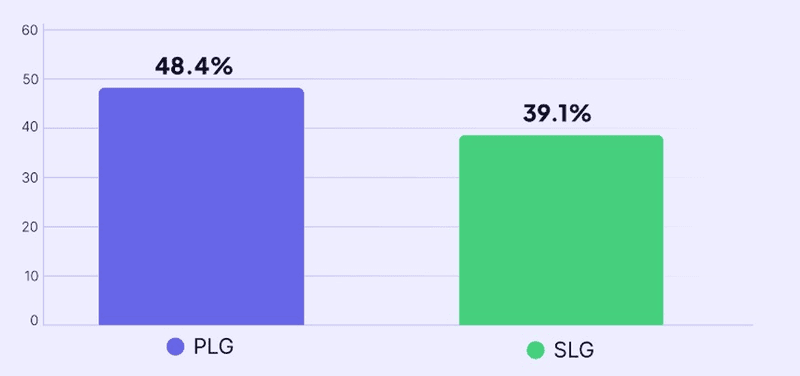
How to improve 1st month retention rate?
Improving month-1 retention involves ensuring users find value in your product early on and continue to engage with it.
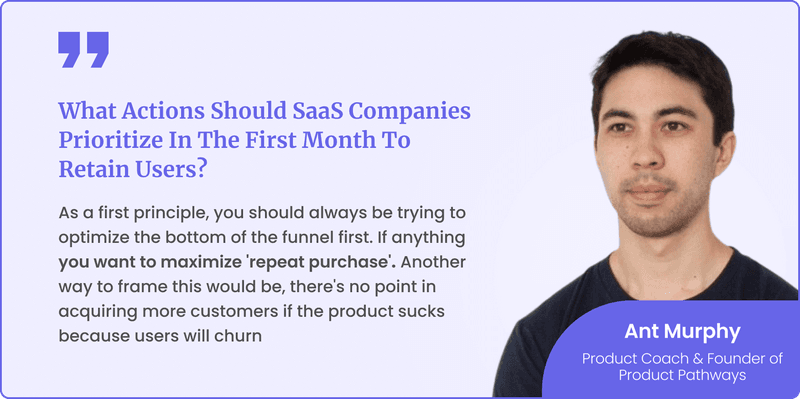
Here are effective strategies to achieve this:
Provide seamless onboarding experience
Providing a personalized onboarding experience opens the door to driving more customer success and increasing customer retention.
The best way to do it is by segmenting your user base and creating a relevant onboarding sequence for each.
For instance, you can use a welcome survey to gather information such as the user’s industry, their role within their organization, or their main motivation for using your product. Then craft an onboarding path that addresses their specific jobs-to-be-done (JTBD) and responsibilities.

Provide consistent customer support
A great opportunity to retain new users is through an in-app resource center. As it prevents users from leaving your app to solve their issues and experiencing friction in the process (preventing them from potentially churning).
That said, here’s how to create an effective knowledge base for your app:
- Identify common issues that make customers drop off and disengage.
- Survey your users, review your support tickets, and examine your usage data to see what’s causing friction and pushing customers away.
- Create help resources in different formats to directly tackle these challenges. These can include FAQs, tutorial videos, step-by-step guides, or help articles.
- Organize your resources in content modules so users can find resources that are relevant to them.
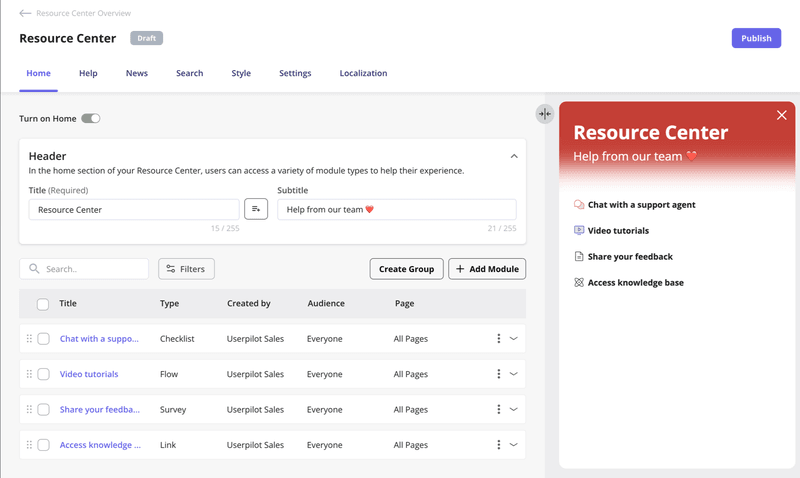
Provide guidance with interactive walkthroughs
Another way to engage customers early on (and prevent churn) is to onboard users on your product’s core features with interactive guidance.
So instead of showing a generic product tour that users are likely to skip, you can implement an interactive walkthrough to:
- Hand-hold users step by step with progressive onboarding.
- Respond to in-app behavior in real-time.
- Avoid overwhelming users with information they won’t retain.
- Enhance the user’s learning experience as they can grasp how to use core features while interacting with the product.
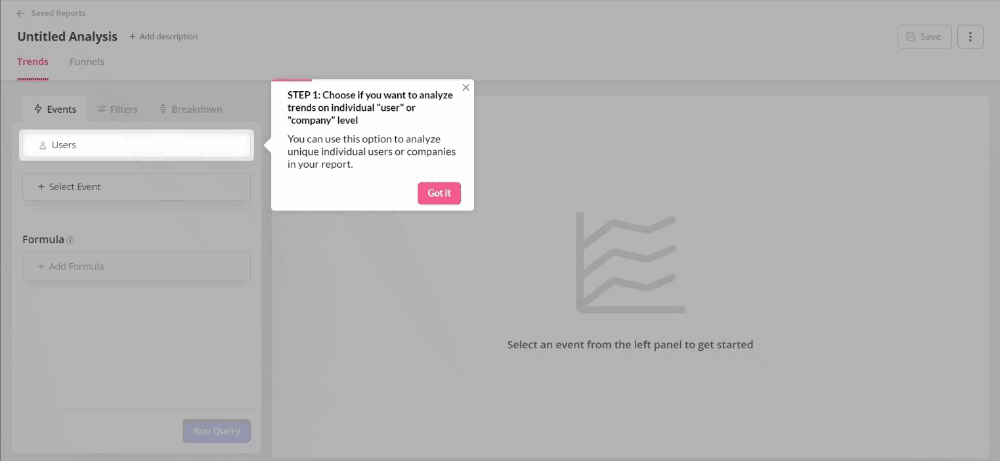
Use gamification to engage users
Gamification can provide a more entertaining experience and create positive reinforcement to keep users engaged from the first month.
For this, you can add elements such as badges and levels to reward users for completing onboarding tasks. As well as daily quests and progress bars to encourage ongoing engagement.
For example, incorporating badges for completing onboarding tasks can motivate users to stay engaged and achieve success with your product—creating an engagement loop that keeps users with your app right from the start.
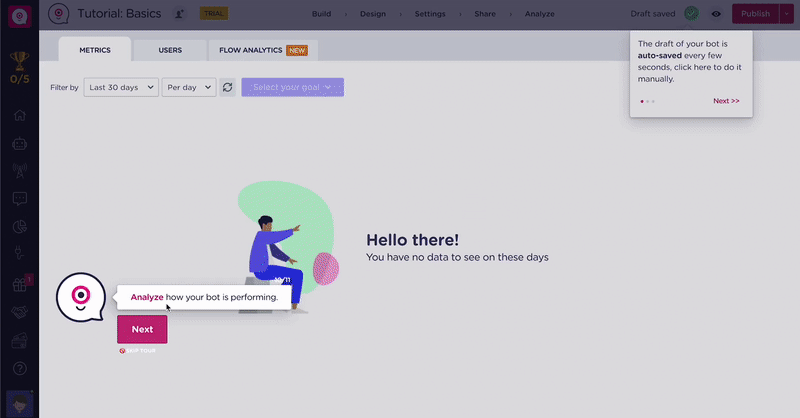
Conclusion
We explored the significance of the month-1 retention rate for SaaS businesses, analyzed the benchmarks, and considered strategies to improve your retention rates.
By providing seamless onboarding, consistent customer support, interactive walkthroughs, and gamification, you can improve early user retention and cultivate long-term growth.
That said, why not book a Userpilot demo today to see how you can personalize the onboarding experience, provide self-service support, and retain more users?





